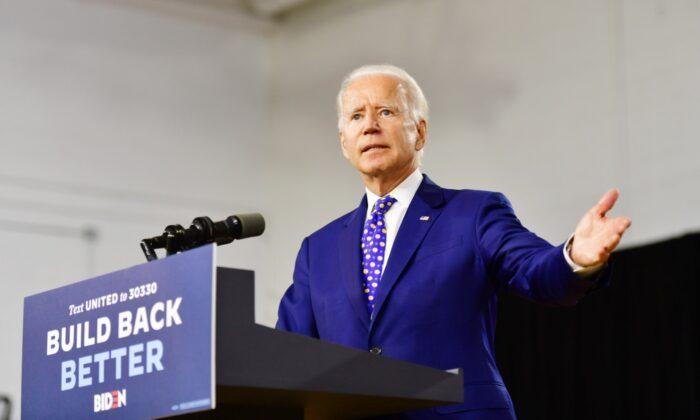WASHINGTON—Joe Biden’s Democratic presidential campaign is reserving $280 million in digital and television ads through the fall, nearly twice the amount President Donald Trump’s team has reserved.
The Biden campaign announced in a Wednesday memo it’s reserving $220 million in television airtime and $60 million in digital ads, in contrast to the $147 million the Trump campaign has reserved, according to a review of Kantar/CMAG data by The Associated Press. Both campaigns can add to or subtract from their reservations at any time.
Biden, the presumptive Democratic nominee, is reserving airtime in 15 states, which includes a number of traditional swing states—Pennsylvania, Michigan, Wisconsin, and Florida—as well as a number of historically Republican states, including Arizona, Georgia, and Texas, and a few traditional swing states that seemed to be moving away from Democrats in recent years, such as Ohio and Iowa. His campaign says a “significant portion” of the reservation will be minute-long ads.
It’s part of an effort to solidify what Biden aides say are the multiple paths to an Electoral College victory open to Biden heading into November. The campaign says it will continue to drive home a message focused on what it says is Trump’s lack of leadership on the coronavirus and that it sees Biden as the best messenger in the ads.
“We think it’s important that people see him, and hear him, because it goes to the issue of leadership, and the kind of reassuring presence and stable leadership which we believe people see in Joe Biden,” said Biden senior strategist Mike Donilon.

But campaign aides said Biden’s vice presidential pick, whom he’s expected to announce next week, will have a “robust presence” on the campaign, including advertising.
On digital, the campaign is reserving ads on streaming services like Hulu, YouTube, and ESPN, as well as podcasts and mobile and online gaming platforms.
The campaign also plans to launch an “unprecedented” paid media campaign to educate voters on their options for voting, heading into an election year when record numbers of voters are expected to vote via mail due to the coronavirus pandemic and new registration and voting requirements and options have cropped up in states nationwide in recent months. Patrick Bonsignore, the campaign’s director of paid media, said much of the campaign’s reservation is focused on the summer and early fall, when early voting starts in some key states.
“We know that in a pandemic, we are in unprecedented times,” said Biden campaign manager Jen O’Malley Dillon. “We’ve seen chaos in recent primary elections, and we know that our responsibility is to make sure that we give voters everything they need to be able to vote, vote early, and vote safely. We believe that our advertising strategy is going to do just that and serve as a way to break through from a lot of the misinformation out there.”
In the memo, Biden’s aides also highlighted their advertising efforts aimed at key constituencies, like black, Latino, and Asian American and Pacific Islander voters. They say they’re able to reach about half of all black households nationwide through their reservations on key black media properties and note they’re airing ads that feature different Spanish accents targeting diverse Latino populations in key regions nationwide.
At the Trump reelection campaign, spokesman Tim Murtaugh tried to frame Biden’s expanding footprint as a sign the Democratic challenger is in peril.
“We look forward to the Biden ad that brags about surrendering his entire agenda to socialists Bernie Sanders and AOC,” Murtaugh said, referring to Biden’s recent policy work with Sanders, his former 2020 primary rival, and Rep. Alexandria Ocasio-Cortez. “This is clearly an attempt to cover up the fact that he’s playing defense, running ads in Colorado, Nevada, New Hampshire, Minnesota, and Virginia? Bad signs for Biden.”
Murtaugh named five states that Democratic nominee Hillary Clinton won in 2016.
According to data from Kantar/CMAG, a market research and consulting firm, Trump’s advertising effort also involves a considerable amount of defense. His five largest state outlays thus far are Florida, North Carolina, Pennsylvania, Ohio, and Michigan, all states where he topped Clinton four years ago.





